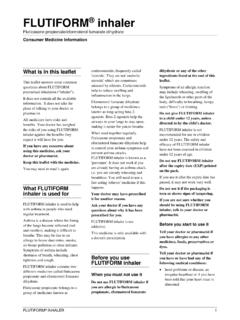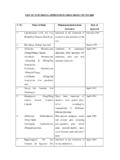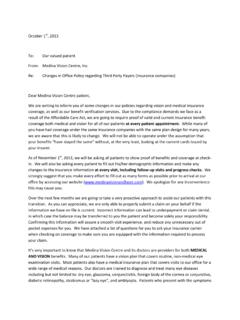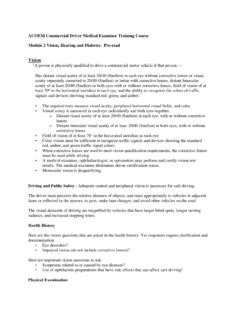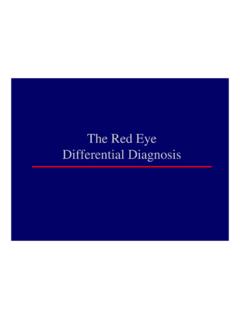Transcription of 2. QUALITATIVE AND QUANTITATIVE …
1 Internal document code 1 Cyc110418iNZ NEW ZEALAND DATA SHEET 1. PRODUCT NAME CYCLOGYLTM (cyclopentolate hydrochloride) Eye Drops 2. QUALITATIVE AND QUANTITATIVE COMPOSITION Each mL of Cyclogyl contains cyclopentolate hydrochloride 10 mg in 1 mL. The pH of the drops is approximately Excipient with known effect Benzalkonium chloride mg in mL as a preservative. For the full list of excipients, see section 3. PHARMACEUTICAL FORM Eye drops, solution. 4. CLINICAL PARTICULARS Therapeutic indications For mydriasis and cycloplegia in diagnostic procedures. For some pre- and post-operative states when mydriasis is required and when a shorter acting mydriatic and cycloplegic is needed in the therapy of iridocyclitis.
2 Dose and method of administration Adults One drop, followed by a second drop in 5 minutes. Complete recovery usually occurs in 24 hours. Children One drop is instilled in each eye, followed 5 minutes later by a second application if necessary. Pretreatment with Cyclogyl Eye Drops on the day prior to examination usually is not necessary. In order to minimise systemic absorption, apply pressure to the tear duct for two minutes immediately after administration. Contraindications Should not be used when narrow-angle glaucoma or anatomically narrow angles are present, or when there is hypersensitivity to cyclopentolate hydrochloride or any component of this preparation (see Section List of excipients).
3 Special warnings and precautions for use FOR OPHTHALMIC USE ONLY - NOT FOR INJECTION. General This preparation may cause psychotic reactions, behavioural disturbances and other CNS disturbances in patients with increased susceptibility to anticholinergic drugs. This is especially true in younger age groups, but may occur at any age. Premature and small infants are especially prone to CNS and cardiopulmonary side effects from systemic absorption of cyclopentolate and, therefore, Cyclogyl Eye Drops should not be used in Internal document code 2 Cyc110418iNZ these patients. Use with caution in patients, especially children, who have previously had a severe systemic reaction to atropine.
4 Cyclogyl may cause increased intraocular pressure. The possibility of undiagnosed glaucoma should be considered in some patients, such as elderly patients. Caution should be observed when considering the use of this medication in the presence of Down's syndrome and in those predisposed to angle-closure glaucoma. To avoid inducing angle-closure glaucoma, determine the intraocular pressure and an estimation of the depth of the anterior chamber should be made prior to the initiation of therapy. Complete recovery of accommodation usually occurs within 24 hours, however, in some individuals complete recovery may require several days.
5 Because of risk of provoking hyperthermia, use with caution in patients, especially children, who may be exposed to elevated environmental temperatures or who are febrile. Information for patients Cyclopentolate eye drops may cause drowsiness and blurred vision. Patients should be advised not to drive or engage in other hazardous activities while pupils are dilated, unless vision is clear. Patients may experience sensitivity to light and should protect eyes in bright illumination during dilation. Nasolacrimal occlusion or gently closing the eyelid after administration is recommended. This may reduce the systemic absorption of medicinal products administered via the ocular route and result in a decrease in systemic adverse reactions.
6 Parents should be warned not to get this preparation in their child's mouth and to wash their own hands and the child's hands following administration. After cap is removed, if tamper evident snap collar is loose, remove before using product. Do not touch the dropper tip to any surface as this may contaminate the solution. A transient burning sensation may occur upon instillation. Contact Lenses Cyclogyl Eye Drops contain benzalkonium chloride which may cause eye irritation and is known to discolour soft contact lenses. Avoid contact with soft contact lenses. Patients must be instructed to remove contact lenses prior to application of Cyclogyl Eye Drops and wait 15 minutes before reinsertion.
7 Paediatric use Cyclogyl 1% Eye Drops should not be used in small infants as concentrations greater than are not recommended due to the risk of serious systemic side effects (see Section Special warnings and precautions for use, Section Undesirable effects and Section Overdose). Increased susceptibility to cyclopentolate has been reported in infants, young children and in children with Down syndrome, spastic paralysis or brain damage to central nervous system disturbances, cardiopulmonary and gastrointestinal toxicity from systemic absorption of cyclopentolate. Cyclopentolate should not, therefore, be used in premature and small infants and should be used with great caution in young children and in children with Down syndrome, spastic paralysis or brain damage.
8 See Section Special warnings and precautions for use, General. Seizures and acute psychosis induced by cyclopentolate are especially prominent in Internal document code 3 Cyc110418iNZ children. Cyclopentolate should be used with caution in children, with known epilepsy. Fair-skinned children with blue eyes may exhibit an increased response and/or increased susceptibility to adverse reactions. Observe infants closely for at least 30 minutes following instillation. Feeding intolerance may follow ophthalmic use of this product in infants. It is recommended that feeding be withheld for 4 hours after examination Parents should be warned not to get this preparation in their children's mouth or cheeks and to wash their hands and the child's hands or cheeks following administration.
9 Use in the elderly In the elderly and others where increased intraocular pressure may be encountered, mydriatics and cycloplegics should be used with caution. Elderly patients may be a higher risk for undiagnosed glaucoma as well as cyclopentolate induced psychotic reactions and behavioural disturbances. Hepatic and renal impairment No formal studies have been conducted in patients with renal or hepatic impairment. Interactions with other medicinal products and other forms of interactions The effects of Cyclogyl Eye Drops may be enhanced by concomitant use of other drugs having antimuscarinic properties, such as amantadine, some antihistamines, phenothiazine antipsychotics, and tricyclic antidepressants.
10 Cyclopentolate may interfere with the anti-glaucoma action of carbachol or pilocarpine; also, concurrent use of this medication may antagonise the anti-glaucoma and miotic actions of ophthalmic cholinesterase inhibitors. Fertility, pregnancy and lactation Pregnancy Pregnancy Category B2. Animal reproduction studies have not been conducted with cyclopentolate. It is not known whether cyclopentolate can cause fetal harm when administered to a pregnant woman or can affect reproductive capacity. Cyclopentolate should be administered to a pregnant woman only if clearly needed. Breast-feeding It is not known whether this drug is excreted in human milk.











